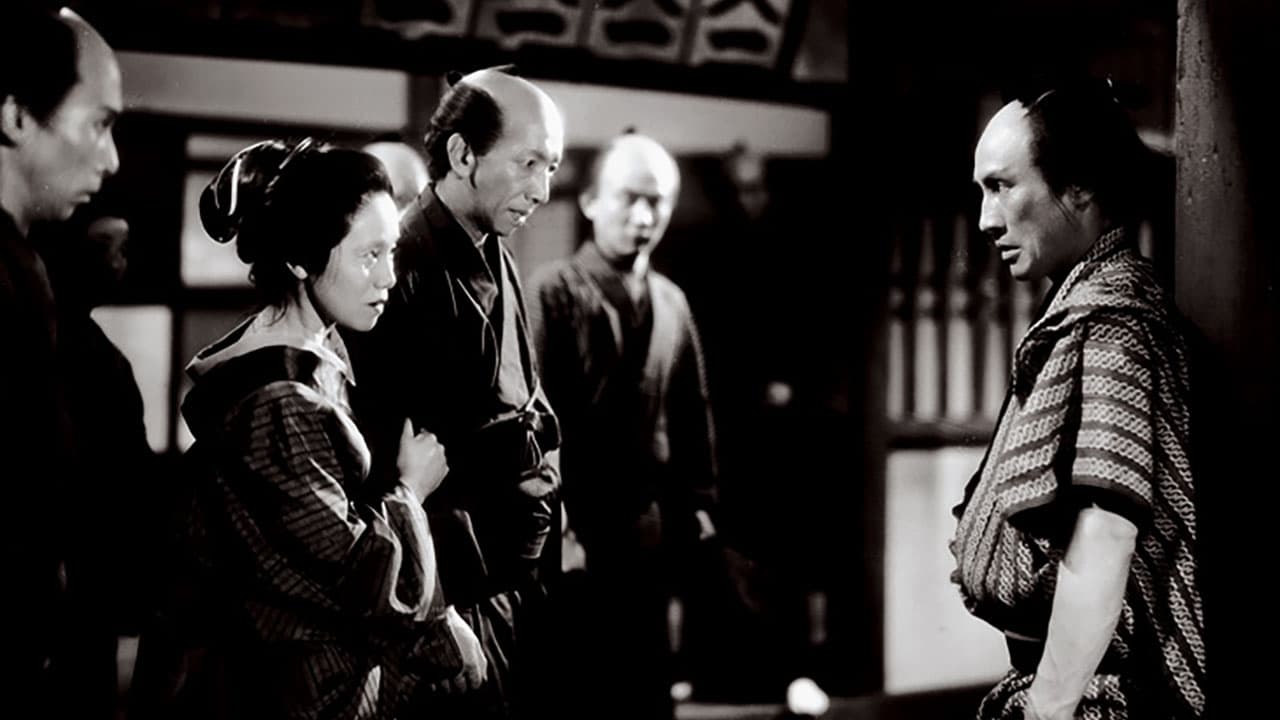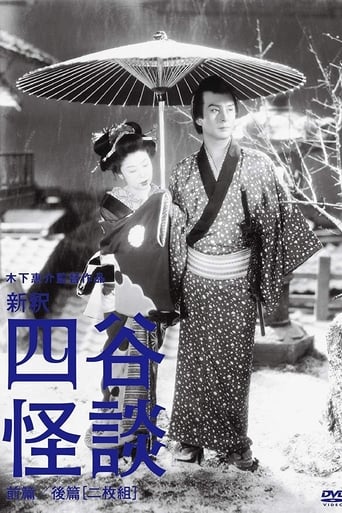

THE YOTSUDA PHANTOM / YOTSUYA KAIDAN, PART ONE / GHOST OF YOTSUYA / THE YOTSUYA GHOST STORY (YOTSUYA KAIDAN / SHINSHAKU YOTSUYA KAIDAN: ZENPEN). Viewed on Streaming. Score = five (5) stars; lighting = three (3) stars; subtitles/ translations = three (3) stars; restoration = two (2) stars. Director Keisuke Kinoshita's Edo-Period soap-er involves an unemployed samurai reduced to making oil-paper umbrellas and married to a former sex worker. The samurai is looking to move up the socioeconomic food chain by marrying into a wealthy family. His wife is looking to remain a De Facto slave who worships her husband while being pursued by a love-obsessed petty thief just out of prison. Tossed into this melodrama pot is a craven, sinister character whose specially seems to be the permanent removal of unwanted spouses, especially wives. Kinoshita is apparently stretching things out to fabricate two movies out of one. The film is too long by about a third as it meanders into boredom with endless scenes of a vacillating samurai unable to decide if, when, and how to shed is lower-class wife. Actress Kinuyo Tanaka in the role of the wife is allowed to go way beyond over-acting to the point where the viewer simply can't wait for her character's demise! Cinematography (narrow frame format, black and white) is okay. Sound stage lighting is frequently less than adequate to see what is happening. Subtitles need to be spell/grammar checked. Signs (of which there are many) are not translated. Score is continuous and good. Restoration (if any) is pretty much absent. Age deterioration is constantly heard and seen along with audio artifacts, broken frames, and poor splices. Despite the title (kaidan), ghosts are among the missing. Not especially recommended. WILLIAM FLANIGAN, PhD
... View MoreTragic melodrama almost plays like like a sordid soap opera. It features a poor master-less Ronin, Iemon Tamiya desiring to live a more lavish lifestyle, stuck in a marriage with Oiwa, who practically worships him, completely indebted to the samurai for pulling her out of a destitute state of being. A recently released criminal, Kohei, who went to prison out of love for Oiwa(..when she worked in a teahouse)survived countless beatings among other harsh treatments just so he could see her again. Kohei's love is obsessive, to the point of borderline madness..he frightens Oiwa who adores Iemon, her husband, and, at one point, calls on elder neighbor Takuetsu for help to get him off her property. Meanwhile, snake-in-the-grass Naosuke(..who was in prison with Kohei; a rat who snitched on his fellow inmates regarding their plan on a prison break)has his own plans for gaining wealth, working as a gardener, manipulating Iemon into perhaps poisoning Oiwa so that he could marry a rich merchant's daughter, Oume. If Naosuke can convince Iemon to poison Oiwa, he can use the crime against him for blackmailing purposes. Thanks to Oume's maid, Omaki, Naosuke is able to arrange get-togethers between her and Iemon with an affair on the horizon. While Iemon slowly grows more tired and frustrated with Oiwa's clinging devotion, and, more importantly, his low status as a Ronin living in near poverty, Naosuke goads Kohei into advancing his cause for his obsession's cooperation. It seems, after all is said and done, Naosuke's concocted scheme might eventually pay off after a confrontation between Iemon and Oiwa results in her face falling into hot water, a burnt face made worse by tampered ointment. With Oiwa's face scarred, Iemon convinces her to take her medicine, laced with poison provided by Naosuke, others interrupt the perfect crime such as Kohei and Takuetsu unannounced, resulting in further violent activity.I entered the film thinking this was a ghost story regarding a tragic victim haunting the lover who killed her. But, THE GHOST OF YOTSUYA PART I, in actuality, sets the stage for the haunting in the second film. We are introduced to Yomoshichi briefly at the beginning, a childhood friend of Kohei who greets him after noticing him in the streets in a sullen, depressed mood. Yomoshichi's wife, Osode, looks almost exactly like Oiwa. They will obviously play a greater role in the second film after Oiwa's horrifying death at the hands of Lemon and Naosuke. THE GHOST OF YOTSUYA PART I is a somber tale of misery and betrayal, with a vile criminal mastermind, Naosuke, planting the seeds alcoholic Ronin Iemon would eventually carry out, the premeditated murder of innocent Oiwa, a victim of circumstances connected with greed and class status. Practically every character within the film is miserable..perhaps a projected view of life during that time in a Japanese village. If you aren't part of a specific powerful clan or family, life can be difficult. I think films within the genre which focuses on the life of a samurai, you often see how important class status is. The character of Iemon properly exposes such a case, his misery is apparent and he wants out of the marriage, despite his feelings for Oiwa(..who had a miscarriage after falling from a stool;you also see, throughout the film, how clumsy she can be)seeing that a life with Oume means reclaiming honor and status, vital ingredients to a samurai.
... View MoreThe first notable postwar film version of the Kabuki play Tokaido Yotsuya Kaidan by Nanboku Tsuruya. It was first performed as a Kabuki play in 1821 and after 1900 made into many films. The play is actually based on contemporary incident of a lower-class samurai wife who went insane and disappeared after discovering that her husband had got another woman pregnant. In Nanboku's play the husband has someone poison his wife so that he could marry into a rich family, and the dead wife becomes a ghost who haunts him.Lemon her husband does not feel any guilt for his actions, but still is presented as a despicable character responsible for the heroine's plight. Kinoshita presents the appearances of the dead Oiwa as simply the hallucinations of Lemon's guilt-wracked mind. When he commits suicide - a divergence from Nanboku's inconclusive ending where he remained alive - it is obvious he died from pangs of conscience rather than supernatural causes. The film was more a psychological drama than a horror story.Made again in 1959 by Nobuo Nakagawa, and in 1965 by Shiro Toyoda.
... View More